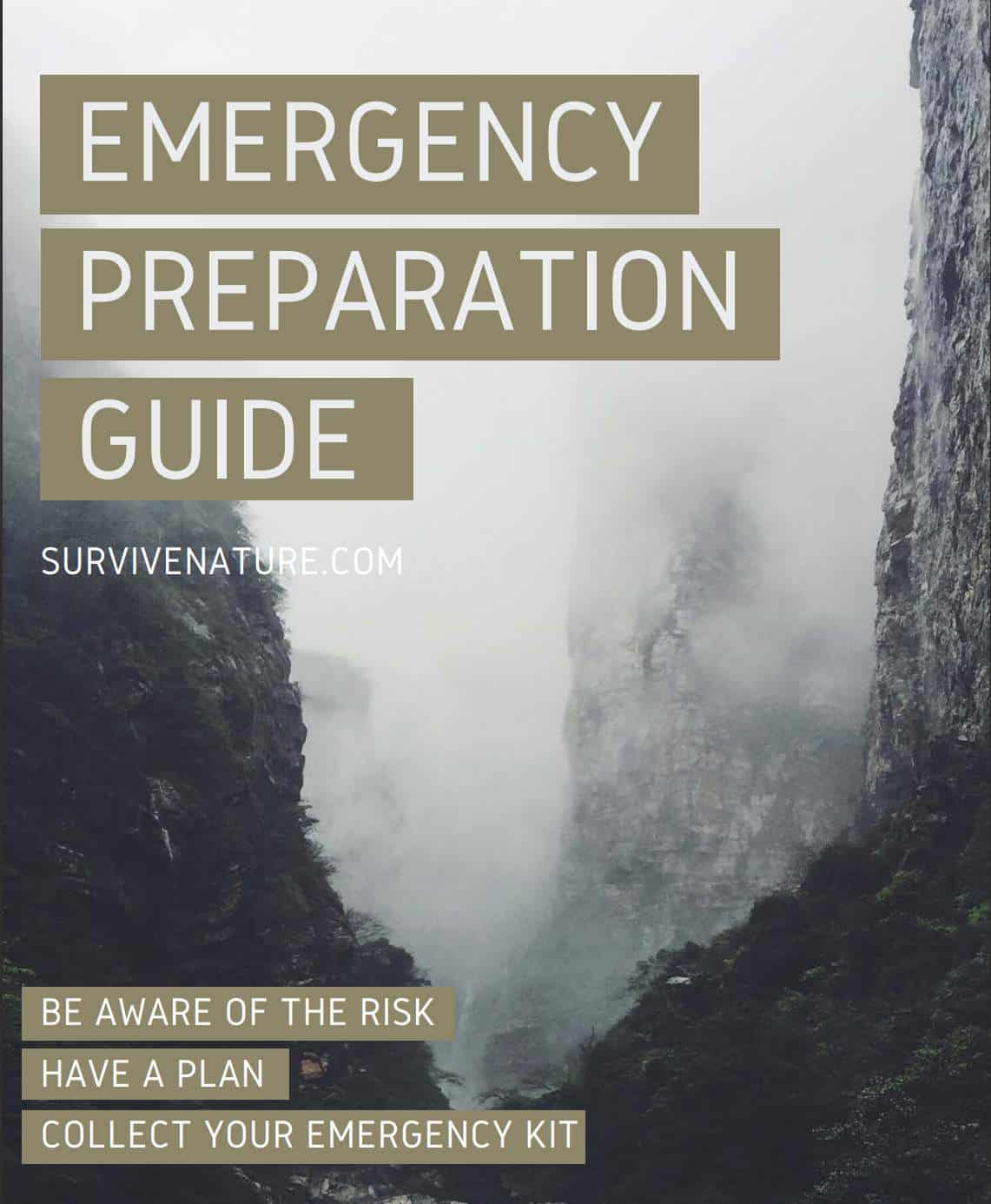Can you tie a survival knot in 2023? It’s not just about friction knots for climbers – a fishing knot can save your life, preppers! You will learn how to tie a bowline, an overhand, a clove hitch, a square, a sailing knot, a half hitch, a noose, an overhand loop knot, and a figure-eight knot (including a figure eight on a bight). We will explain the details – from what a standing part of the rope is and how to hold the working end and adjust the tension to why you need a sheet bend and what paracord to choose (good cordage is essential!). It will seem as easy as getting the cord through the eye of the loop.
Some activities from childhood can be very useful at a more conscious age. Especially if you were fond of tying a rope or paracord knots.
This skill has come in handy for absolutely all hiking and other types of tourism fans at least once in their life. It doesn’t matter whether the camper is a professional or an amateur. The skill of tying strong knots is very important, especially when you have to tie numerous pieces of rope together.
Knots are frequently used in emergency and rescue situations, so choosing the right type of knot and the ability to make it can save your life quickly.
This article has collected the five most popular types of survival knots to help you in any camping situation or the mountains. Besides, to learn how to tie them correctly, watch the video tutorials attached under each type of knot terminology section. Finally, it doesn’t take much to be a pro. Just take your time and practice well.
Get more informed and prepared for literally anything with our extensive blog:
Eight-Shaped Knot
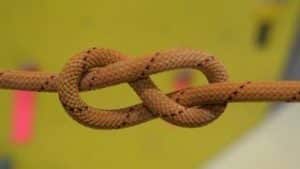
This type of knot tying is simple and very reliable. There are three types of this knot: the usual figure-eight knot, the eight on a bight, and the follow-through eight.
The first type of figure-eight knot is easy to tie. The rest are its modifications, improvements. This survival knot is not only the most versatile but also the most effective. It retains about 85% of the strength of the rope, allowing you to extend its maintenance.
Survival Knot Appliance
The easiest way to tie a figure-eight knot can be used as insurance to keep you from slipping. The pressure does not untie the rope, and you can also make knots along the entire length of the rope so that you can climb.
And the follow-through eight-shaped knot helps even better when you need to lift someone. You need to make a loop at the end and secure it, so you can grab the loop. This is indispensable for situations when the weather is raging.
Please, take a look at our complete checklist with all the survival gear you need.
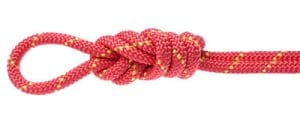
The eight on a bight type of knot is good as an addition to an anchor, especially when you need to transfer things in severe weather.
You make a loop at the end of the rope, which is actually attached to your anchor. If you want to create something like a ladder, just make a few more loops along the rope’s length for the hands and feet.
Disadvantages for Preppers
Of course, the figure-eight knot has disadvantages. And the biggest one is that it’s very challenging to untie it, particularly if a large load has been applied and you have used this “structure” several times in a row. Also, you will need a really long rope for such knots. But if you did something wrong, you will immediately notice it.
The Blunders
A very popular mistake is when you add an unnecessary loop, but it’s easy to spot right away. It is also very important to knit a control stopper knot. After tying the figure-eight knot with the control stopper knot, the rope’s tip should remain from five to seven centimeters long.
Below is the video guide on how to accurately make an eight-shaped knot:
Clove Hitch Knot
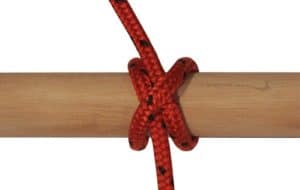
This type of knot is used when you need to connect things with a rope. The clove hitch is also very easy to tie and, at the same time, very strong.
The knot’s good thing is that it requires a short rope and is simple to adjust without breaking the knot itself. It does not slip and protects against loosening.
Survival Appliance
Yes, the clove hitch knot may not be the strongest one. But it can be modified in the process without any effort, and still, it will be stable.
If you need to raise or lower heavy equipment, this knot will be perfect for you. It can also be used for transporting goods, constructing a rope crossing (for example, over a small stream).
Disadvantages
Of course, when you use one rope and the knots on it for wear and tear, they will loosen and create some inconvenience and possible problems with stability. But you can fix it if you check its state from time to time.
We recommend reading our comprehensive list of survival equipment to know what you should bring on your trips.
The Blunders
This type of knot is often used for hitching fixed items such as tent lines. The pressure applied to the rope makes the knot stable. Therefore, you should not use this knot to hold together moving objects because this way, the clove hitch knot may be untied.
You will learn how to tie the clove hitch by watching the video:
Bowline Knot
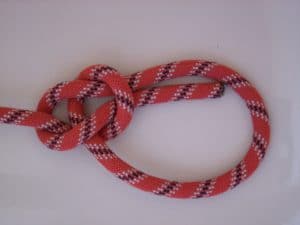
The bowline knot is multifunctional, and you can use it anywhere and in any situation. Compared to the figure-eight knot, it is much easier to unlace after use. Under load, this knot does not split or slide along the rope. However, just like the figure-eight, it is very strong and can handle a huge weight.
Survival Appliance
One of the main advantages, the bowline knot is easy to untie under pressure. It does not tighten too much. In mountaineering and rock climbing, it is often used to create a load loop, organize a station on a rigid support (a rope line to a tree, for example).
This way, you tie a knot of the rope around the support and then the actual rope around your waist. The bowline knot can be tied with one hand. This is very useful if the other hand is busy or injured.
Climbers usually pass the end of the rope not into the loop itself but under the “rim” of the ropes to form a tie, but they can also tighten the rope’s end, forming a double running knot on it to an additional loop or free end.
The more load is applied to the loop, the more it tightens. Therefore, equipment or bags with food on the camp trees are hung on this particular knot.
Disadvantages
When the knot is unloaded, the vibrations untie it. The bowline knot is not a good belay for climbers, as if it is pulled to the side, it will surely break. But you can prevent the tragedy just by checking out this theory (on the stable ground, of course).
The Blunders
Everything is simple here. Don’t forget about the last required step. Use the control knot. Otherwise, the bowline survival knot will come loose and bad things will be likely to happen.
You can see how to tie the bowline knot here:
Taut-Line Hitch Knot
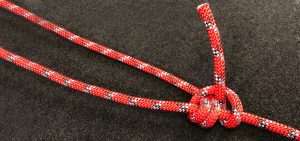
The taut-line hitch knot is also included in our top survival knots. You need to know mainly because it is convenient to tie some stuff that has to slide the entire length of the rope pulling it tight.
In this way, the applied pressure can be changed without losing the tension force. It is also very easy to untie the taut-line knot after use.
Survival Appliance
In most cases, the taut-line knot is used to install a tarp. You simply pull a strong cord or thick rope together with knots between the trees and put a tarp on top of it.
Therefore, the loop grips and slips so that it lets you stake easily in your water-resistant tarp in the woods/mountains or especially when you practice rock climbing.
Disadvantages
This knot is not suitable for tensioning. It can only be used for simple jobs without heavy loads. Besides, the knot will often need to be checked and serviced.
Please, feel free to examine our astonishing backpack gear checklist to be fully equipped for any survival situation.
The Blunders
Be sure to pay attention to the position of the rope end. They must be placed in the same direction. Otherwise, you can change the course of rotation.
Different types of taut-line hitch knots are tied in different ways. The knot above is called Midshipmen’s Hitch. It is much stronger than the usual one, but it is a little more difficult to untie.
The Magnus Hitch survival knot is even more difficult to tie but provides a smoother slide. However, to tie it correctly, you need to consider the necessary change in the last half hitch direction.
Here’s how you can do the taut-line hitch:
Sheet Bend Knot
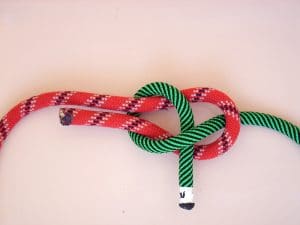
The sheet bend is ideal for situations where you need to tie several shorter pieces of rope together to make a long one out of them, regardless of what materials and what lengths each of them are. This knot will help you make a large and strong rope.
Survival Appliance
The sheet bend is one the most applicable in all cases. This knot is a great adjustment for any paracord or rope. So, you can do a lot when you are tying this knot.
You can make a cargo net very easily. Just tie two ropes together with the sheet bend. That’s if you have a lot of paracord and rope of different lengths, and all of them are not suitable for independent use.
The cargo net, though, is very serviceable and is used almost everywhere. With such a net, people make stretchers and hammocks, where the cargo net itself functions as a foundation.
Disadvantages
The sheet bend sort of knot is not the strongest, it’s true. It may come loose if you are using a rope with insufficient roughness or if it’s poorly tied. And the tensile strength of this knot, by the way, is as much as 55%, which is not very good.
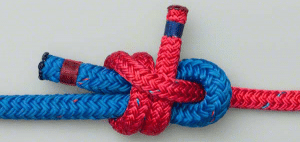
It is recommended to double sheet bend with a shorter rope when using two ropes of diverse lengths. This will make your sheet bend more stable.
The Blunders
People often make such mistakes by tying with the short end of a rope on the sheet bend knot’s bogus side. There’s even a name for this kind of situation, “left-hand sheet bend.” But! It’s really easy to prevent it. You just need to make sure that both loose rope ends placed on the same side of the sheet bend knot.
Final Thoughts
Knowing how to tie the knots is helpful, but not enough. You need to be able to use knots in various circumstances. Not only one person’s life, but also the whole group’s depends on the ability to tie the knots correctly and then use them.
Due to the fact that it is necessary to tie a knot very quickly and in uncomfortable conditions (which happens quite often), a person should be able to do this automatically, without hesitation, using motor memory. Therefore, you should pay great attention and time to knot tying.
Knowing the kinds of knots is very valuable because a knot tied incorrectly or not quickly enough can lead to very tragic consequences, such as rescue from fire or any other disaster.
Or, when you find yourself in nature and search for food, you will need to come up with something to hunt successfully: make a trap or tie a reliable fishnet. And what is more likely to happen when you are in bad weather, and you need to build a secure shelter using the ropes and paracord.
The five knots that we have given in the article are basic, universal, and the easiest to remember. Start practicing now because it can come in handy at any time.
FAQs
How do you tie a knot for survival?
You can tie a survival knot following the special guides. If you need to use a rope of unknown material, first test the knot you want to use in a safe environment. After all, knots’ features change even for a rope with the same material but with different thicknesses.
What is a good strong knot?
It depends on the purpose for which you are using a particular kind of knot. Anyway, a reliable knot is one that has been thoroughly analyzed and tested by professionals and time, and that’s all about the technique and patterns of tying. Implementation, however, depends only on you and your skill level.
How do you tie a knot?
Each knot must be tied according to its own special instruction. Once you understand the pattern, tie the knot several times, choosing the most comfortable method. After all, different people tie the same knot in different ways.
How do you tie a good strong knot?
Inexperienced people easily forget how to tie the knot. Therefore, if you want to constantly use any particular knot that would be stable, you need to tie it many times, bringing the tying process to complete automatism. And then you need to repeat the tying workout regularly.
Best survival knots every prepper should learn.
All rope knots are unique. Each has its own purpose. We discussed each kind of knots in detail in the article above. These rope knots are the easiest to tie and, at the same time, widely applicable.
What would happen if you were the last person on Earth?
It is difficult to imagine that seven billion people will disappear immediately or gradually but in a short period of time. But one thing is clear for sure, very quickly, the infrastructure will become unusable and dangerous. This scenario has already been used in many books and films, though.
Surviving alone in the conditions of the apocalypse is extremely challenging, both morally and physically. It is essential to study all the survival methods to study what equipment you may need to have great endurance and ingenuity.
Read articles on everything you need to know during apocalypse survival on our website.


